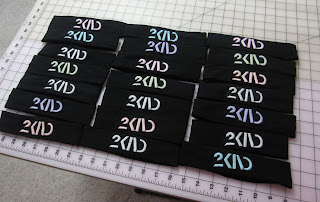Here is a larger picture of the Stat Icon options for the bibs, burp cloths, toddler shirts, and pillow covers available at NausicaaDistribution.Etsy.com.
Thursday, September 26, 2013
Monday, July 9, 2012
2KIND Project
My youngest sister began something last September, its called the 2KIND Project. She says:
She prints and sells t-shirts with the 2KIND logo to raise money for charity.
One of her upcoming events is to have a group of about 20 people participate in the Glow Run 5K. Usually, she has her group wear matching t-shirts, but those are provided by the 5K, so she is trying something different: headbands. That's where I come in. We figured out how to make some simple headbands and embroidered them with the 2KIND logo...
in glow-in-the dark thread.
I learned some things throughout the process. Allow me to share. For those of you who find yourselves making and embroidering headbands, here are some tips I've discovered:
I began 2KIND during a time that I wasn't completely happy. I was miserable at my job and I felt like I wasn't doing anything that was important or making a difference.
She prints and sells t-shirts with the 2KIND logo to raise money for charity.
My hopes for those who purchase a shirt off of this site is that you will not only proudly wear the logo across your chest, but that you will also take a step in being 2KIND every day.Since then, she's become happy and has met her 2KIND goals, just about twice now. Girls on the Run of the Kansas City Metro Area as her charity this year. Along with selling t-shirts, she also helps organize volunteer groups, promote kindness, organize groups for 5K's, and a variety of other nice things. You could check out her webpage or Facebook to see more information.
Making a difference, one shirt at a time.
One of her upcoming events is to have a group of about 20 people participate in the Glow Run 5K. Usually, she has her group wear matching t-shirts, but those are provided by the 5K, so she is trying something different: headbands. That's where I come in. We figured out how to make some simple headbands and embroidered them with the 2KIND logo...
in glow-in-the dark thread.
I learned some things throughout the process. Allow me to share. For those of you who find yourselves making and embroidering headbands, here are some tips I've discovered:
- Cut your knit (I used the thickest I could find)* in rectangle approximately 16" by 4.5".
- Machine embroider with lots of stabalizer. I used: 1 layer of sticky, 1 layer of iron-on, (the fabric), and 1 layer of ultra-solvy.
- Underfill the area before stitiching the design. This helps with non-distortion of the pattern when the fabric is stretched.
- Don't use thick glow-thread. It just bunches up.
Posted by
ND
at
9:30 AM
|
Labels:
2KIND,
embroider,
embroidery machine,
facebook,
glow-in-the-dark,
headband,
knit,
terry cloth,
tips
|
0
comments

Sunday, July 1, 2012
Cross-Stitch from the UK
Here is another example of the P-value cross-stitch guide. These images come to us from Ned in the United Kingdom. His girlfriend, Sara, stitched up the piece for their friend - a Lecturer in Psychology - at
the University of Oxford.

Thanks to Ned for the pictures. And hope your friend enjoys!
Posted by
ND
at
5:16 PM
|
Labels:
birthday,
cross-stitch,
customer,
Oxford,
p-value,
pattern
|
0
comments

Tuesday, May 1, 2012
2012 AgStat Conference
We just got back from the 2012 Conference on Applied Statistics in Agriculture at K-State. It was great to see some of our professors and some old classmates. We also got to talk to some current statistics students from around the area and listened to a couple of really good talks.
Really glad we got to go and looking forward to attending next year's conference, too!
Really glad we got to go and looking forward to attending next year's conference, too!
Tuesday, October 4, 2011
Lessons from Moneyball
Over the weekend Nicole and I got out of the house and watched Moneyball. I believe this was the first movie that we have watched in the theaters since our daughter, Keagan, was born about a year and a half ago. We aren't too much into watching movies in the theater in the first place, but we figured we should go out an support a good story about data and statistics trumping “conventional wisdom”.
The movie is the (mostly) true story about how Billy Beane (Brad Pitt), the Oakland Athletics general manager, turned their very small budget into a wining team by rethinking what makes a winning team. The old timers in the organization wanted to replace key players from the team that were lost, where Billy questioned if there was a better way to build the team from the ground up. Billy meets up with a Yale graduate who looks at baseball through a statistical lens. And together they go about rebuilding the A's.
This movie should be seen by all college students about the power (and more importantly the pitfalls) of applying statistics to their profession. In the movie, Billy assembles his team of undervalued players which were gathered to stay under budget while maximizing the probability of winning each game, from a statistical standpoint.
So they used statistics to overcome their problem, happy ending right? Heh, we aren't even half way through the movie yet. The problem is now an unconventional baseball team is taking the field and the A's manager, Art Howe, is trying to play them like a conventional team -with disastrous results. This is the first great lesson that this movie teaches about statistics. If some decisions are made due to analysis, but then other decisions are made that do not follow the results, the resulting situation could be worse than if no analysis had been done, this is especially true if the analysis suggests results that are not conventional.
Luckily, Billy stood by his team and pulled some trades so that the correct players had to be played. So the A's took the lead in the division, right? After all, decisions were made based on statistical analysis. Not yet, see there is no magic bullet, and even though a good team was assembled and it was being used correctly there still was a lot of ground that the A's had to make up to catch the raw talent that the Yankee's have. Billy then embraces other data driven results about how to play baseball; bunting is abandoned, walking is welcomed, and they strive for easy outs. The movie doesn't spend too much time on this part, but does make note of it. The first important idea here is that there are many areas for statistical improvement in every process, an analysis leads to answers, but also leads to other areas for further improvement. Secondly, Billy took his findings and got the players involved in why the decisions were being made, he didn't just proclaim the decisions made by the analysis, but instead talked with the players about what he found and how the changes can make an improvement. It doesn't matter if something is highly significant, if the people controlling the process do not implement the results of the analysis it is a waste.
So the A's started to win and the great Moneyball experiment was paying off, they broke the record for wins in a row and things were going to plan. So they won the World Series right? Well, no, didn't even make it there. This might be the greatest lesson of the movie. Even though everything was correctly being followed they still lost. The problem is that the regular season is a large sample of games, and over the long haul the statistical results will hold up, but when we look at a playoff series there is only 7 games to play, and there is random chance -even the best teams can lose 4 out of 7 games. So the A's not making it to the World Series is just a case of random chance in a small sample, not a case of a bad analysis. And this is important to remember, generally in statistical analysis we are concerned about the long term results. We shouldn't get discouraged if the results don't come back good right away after implementation, give it time to work towards the long-term means.
It turns out that the ideas that the A's introduced to the league soon became a common way to view baseball and the Red Sox won their recent Championship using the principles.
Statistical analysis is like having an ace relief pitcher or a sure-thing pinch hitter -they could change the game, but only if used correctly.
-Shannon
Wednesday, September 14, 2011
How Times Change
Wednesday, July 13, 2011
My Lack of Cross-Stitching
I have not cross-stitched in a few months. Things have been getting pretty busy, namely we are moving in less than two weeks to a town about 7 hours away. I'm pretty excited about it. I'm going to be teaching math at the community college I attended and my husband is going to start his own statistical consulting business. But before any of that happens, we need to finish moving out of this house and into a new place.
But although I haven't been cross-stitching, others still have! Here is a picture from a customer who recently completed a cross-stitch.

This nerdy piece will grace her classroom in hopes that it helps students remember the important rule.
Thanks for sharing!
But although I haven't been cross-stitching, others still have! Here is a picture from a customer who recently completed a cross-stitch.

This nerdy piece will grace her classroom in hopes that it helps students remember the important rule.
Thanks for sharing!
Subscribe to:
Posts (Atom)










